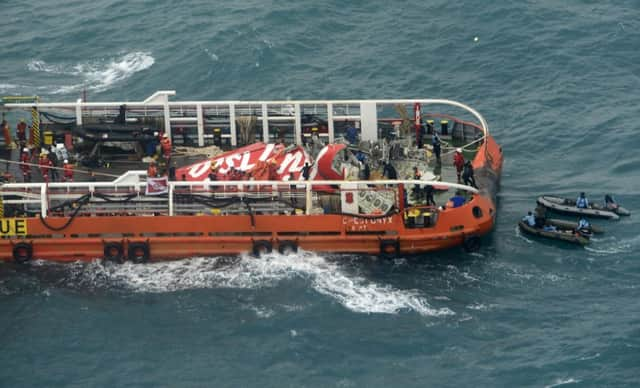Divers may have found AirAsia plane’s black boxes


Three Indonesian ships detected the signals, according to Indroyono Soesilo, the co-ordinating minister for maritime affairs. They were located about two miles from where the aircraft’s tail was discovered.
CONNECT WITH THE SCOTSMAN
• Subscribe to our daily newsletter (requires registration) and get the latest news, sport and business headlines delivered to your inbox every morning
Advertisement
Hide AdAdvertisement
Hide Ad“The two are close to each other, just about 20 metres,” Mr Soesilo said. “Hopefully, they are the cockpit voice recorder and flight data recorder.”
Later, Mr Soesilo said Indonesian divers seemed to have located the flight recorders.
He said if they had been found, divers would try to retrieve them today.
Tonny Budiono, team co-ordinator at the directorate of sea transportation, said the signals had been intense in one area and he believed the recorders were likely to be lodged there beneath wreckage. If divers are unable to free the black boxes, all the debris will be raised.
However, other officials said it was too soon to know whether the sounds were coming from the black boxes, which detached from the tail when the plane plummeted into the sea on 28 December, killing all 162 people on board.
The Commission for Transportation Safety stopped a remote-operated vehicle from being deployed to probe the area where the pings were heard, fearing it could potentially cause damage to the boxes, Muhammad Ilyas, head of oceanic surveys at Indonesia’s technology agency, said.
Sonar yesterday detected a large object in the same vicinity as the pings.
Officials had been hopeful it was the main section of the Airbus A320’s cabin, but the head of Indonesia’s search and rescue agency said divers had confirmed it was a wing and debris from the engine.
Advertisement
Hide AdAdvertisement
Hide AdSearch efforts have been hampered by big waves and powerful currents created by the region’s rainy season. Silt and sand, along with murky water from rivers, have led to poor visibility for divers.
The tail’s excavation was a major success in the slow-moving hunt for victims and wreckage from Flight QZ8501. The red metal piece from the tail, with AirAsia clearly visible across it, was brought to the surface on Saturday using inflatable balloons.
The find was tinged with disappointment when the black boxes were not attached. Their beacons emit signals for about 30 days until the batteries die, meaning divers have about two weeks left if yesterday’s discovery turns out not to be the crucial recorders.
The debris from the tail was brought up from a depth of about 100ft and towed to a ship, where it was hoisted on to the deck.
AirAsia boss Tony Fernandes expressed optimism earlier yesterday that the effort was gaining momentum.
“Let’s hope today is a major breakthrough day and we can find [the] main fuselage,” he wrote in a Twitter post.
Many believe most of the victims’ bodies are entombed inside the aircraft on the seabed. So far, only 48 corpses have been recovered.
Three more bodies were identified yesterday, including Park Seongbeom, 37, and his wife, Lee Kyung Hwa, 34, from South Korea, according to East Java’s Disaster Victim Identification unit.
Advertisement
Hide AdAdvertisement
Hide AdIt said they had been discovered on Friday on the seabed, still strapped to their seats. Their baby had not yet been found, but the infant’s carrier was still attached to the man.
SCOTSMAN TABLET AND IPHONE APPS